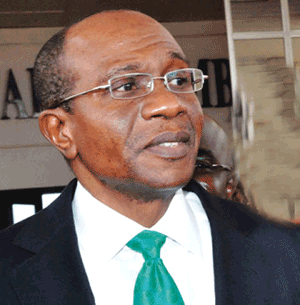It is imperative to explore other ways of making the most of automated teller machines (ATMs) now that the Central Bank of Nigeria (CBN) has re-introduced a charge on ATM withdrawals.
Cash withdrawals from the ATM of a customer’s bank remain free, a charge applies only after the fourth transaction on another bank’s ATM in a month.
What to do
CBN Governor, Godwin Emefiele
The simplest way to avoid ATM fee is to use your own bank’s ATMs. Find out where they are by visiting your bank’s website and use them whenever possible. For instance, GTBank has an ATM Locator on its website.
Avoid withdrawing small amounts of cash when using an ATM to get round the ‘countless daily withdrawals’ targeted by the CBN. Prepare a budget and plan in advance for the amount you need.
Another advantage of an ATM card is that it acts as a debit card by default. You can use it to buy from a retailer with a point of sale (POS) machine. There are no charges for using MasterCard or Visa, and you can use MasterCard to pay for goods and services as frequently as you want.
Opening an account with a bank with a large ATM network is another easy way to avoid paying the charge.
If you have to use another bank’s ATM, plan ahead for how much money you need, and take it all out at once. This eliminates transaction fee payment. If you do not trust yourself with cash, keep it in a safe place until you need it.
Win-win
Analysts describe the CBN’s directive as a win-win for banks and customers because the decision to limit customers to three remote–on-us transactions coincides with the instruction to banks to reduce certain charges or drop others entirely.
GTBank, Zenith, First Bank, United Bank for Africa (UBA) and all other major banks stepped up awareness campaigns as the ATM charges took effect on September 1.
Debate continues
The directive continues to generate debate. Some consumers see free ATM services as the least banks can offer. Some consider it an entitlement. Others are asking, why now? And, how does Nigeria compare with the rest of the world?
There seems to be a great deal of misunderstanding by the public on how the charges will be structured and applied.
Given Nigeria’s new status as the largest economy in Africa and its increasing importance as an emerging market, the country is becoming integrated into the global financial market and practices.
It thus makes sense to do a comparative analysis of ATM charges around the world and see how Nigeria stands.
Rationale for the charge
But let us first look at the CBN’s rationale for the new policy and the key components.
The charge was re-introduced two years after the CBN stopped the N100 fee per withdrawal on third-party ATMs. The original circular was signed by CBN Director (Banking & Payments Systems), Dipo Fatokun.
CBN Director (Corporate Communications), Ibrahim Mu’azu, explained in a follow up statement that the new charge would help banks to keep more ATMs serviceable, making banking more convenient for customers.
Mu’azu maintained that the “charging of fees on interbank networks is a widely acceptable global practice. The new ATM charge will ensure that customers get better services, while increasing healthy competition among banks.
“The transaction volumes at other banks’ ATMs had increased astronomically owing to free cash withdrawal. Indeed, some customers were beginning to abuse the use of ATMs through countless daily withdrawals; this development has led to an increase in cash transactions, which negate the Central Bank’s cash-less policy.
“The CBN wishes, therefore, to reassure the public that the long-term interests and welfare of all bank customers remain the goal of all banking policies.”
As gleaned from Wikipedia, most countries charge fees for ATM transactions, especially when done in a different bank or in high frequency.
Germany
German banks charge for withdrawals at another bank’s ATM. Usual fees are between four or five Euros. All ATMs are connected to the national Girocard interbank network.
ATM owners do usually join one of the ATM groups that mutually lower or waive fees so that customers can withdraw free of charge.
Spain
There are variations in charges in Spain. A card issued by a Spanish bank will normally expect to incur a moderate fee from 0 to one Euro to be applied to ATM withdrawals, where the transaction is conducted on an ATM operated and owned by the customer’s bank.
Sweden
In Sweden, most banks issue debit cards for an annual or monthly fee which includes free withdrawals in Sweden and within the Eurozone. But customers are subject to a fee if using a cash machine elsewhere.
Some cards from some banks are, however, subject to fees also when used in the Eurozone and some Swedish cash machines. Most of these cards are issued by savings banks.
United Kingdom
The United Kingdom charged ATM fees in the 1980s. The large numbers of free-to-use ATMs and the low average number of transactions at pay-to-use machines means that 97 per cent of cash withdrawals remain free of charge.
Indonesia
Banks generally do not charge a fee for ATM use in Indonesia. However, when an ATM card is used outside the home ATM network, service charge applies.
Pakistan
In Pakistan, banks charge a fee of PKR 0 to PKR 20 per non user’s ATM cash withdrawal. These fees are levied chiefly to offset banks’ own costs at par only, without any profit margin.
There are two ATM switches operational in the country, 1LINK, hosted by a consortium of banks; and MNET, hosted by MCB Bank.
All Pakistani banks are members of one or the other switch, as per the mandate of the State Bank of Pakistan, the country’s Central Bank.
United States
Prior to 1988, there was no surcharging of cardholders by ATM owners in the United States. That year, the Valley Bank of Nevada began surcharging “foreign cardholders” (holders of ATM cards not issued by Valley Bank) for withdrawals at its ATMs located in or near Las Vegas casinos.
Eventually, various regional ATM networks, and ultimately the national networks, Plus and Cir-rus, permitted ATM surcharging.
Before 1996, foreign ATM fees averaged $1.01 nationally. As banks and third parties realised the profit potential, they raised the fees.
ATM fees now commonly reach $3.00, and can be as high as $6.00, or even higher in cash-intensive places like bars and casinos.
In cases where fees are paid both to the bank (for using a “foreign” ATM) and the ATM owner (the so-called “surcharge”) total withdrawal fees could potentially reach $11.
South Africa
South Africa is one of the highest ATM withdrawal fee countries. Transaction can sometimes cost as high as 16 Rands.
Banks on awareness campaigns
Nigerian banks are educating customers on the new charge and helping them see that ATM cash withdrawals are still free within the same bank network.
Banks simplify the messages as much as possible in newspaper advertisements, website posting, radio announcements and other means.
GTBank, which has one of the largest number of card holders, sent a circular to customers saying, “as a GTB card holder, it is free every time to withdraw in a GTB ATM. If you withdraw on another bank’s ATM, it is free the first three times every month.
“Please note that for your convenience, GTB has deployed a great number of ATMs placed strategically around the country.”
















